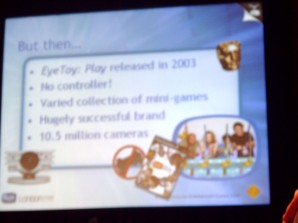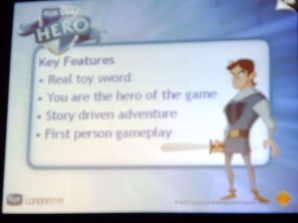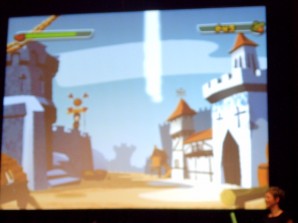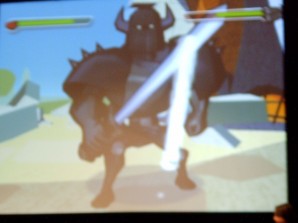Sony to have 1:1 motion-tracking sword game by Xmas
A representative for Sony Computer Entertainment’s London Studios was in attendance at the Edinburgh Interactive Festival yesterday to talk about EyeToy. DarkZero brings you the details.
Sandy Spangler, one of the lead designers on the EyeToy: Play series of games at SCEE London, took to the stage to talk about the history of Sony’s camera peripheral. The first game that fully utilised the camera was EyeToy: Play which was released in 2003, and, according to Sony, was the first ever game without the need for a controller (or remote as they specifically pointed out.)
It seems people loved the idea of motion-based gaming (another jab at the Wii there?) as the varied mini-games in EyeToy: Play went onto spark a hugely successful brand that has resulted in over 10.5 million cameras making their way into PS2-owners homes.
Spangler explained that EyeToy was successful because it was easy to pick-up-and-play and was a great game for kids, families and parties. In fact, it was so successful that it created a whole new genre: Physical and Social Gaming. (Do we sense a little bitterness at the success of the Wii?)
Spangler explained that early EyeToy games worked by recording when pixels change colour in the camera’s field of vision, and viewing this colour-change as motion. This meant that the games could not track specific body parts or gestures, only sense where motion was happening onscreen. (This was why you had the irritation of having to wave your hand vigorously over any icon in the EyeToy menu to get the game to recognise your intentions.)
She went on to explain that Research & Development departments at SCEE London had created a way for the existing EyeToy technology to be able to keep track of specific colours. This lead to the announcement of two new EyeToy: Play games, to be released by Christmas this year. These were named Hero and Pom-Pom Party.
Hero was undoubtedly the more interesting of the two, being the first story-driven EyeToy game. (That means the other eighteen EyeToy games were just gimmicky mini-game collections then?) This title is controlled by means of a fluorescent-green foam toy sword. If you felt silly with a Wiimote in your hand, you’re gonna love this.
As the game can track where the sword is at all times, this allows for more complex gameplay. The first thing to note is that EyeToy Play: Hero is played from a first-person perspective, so the player’s image is not displayed onscreen like most other EyeToy games. What is seen onscreen is a glowing green representation of the sword that the player holds, and as the game is camera-based it follows the player’s movements to an exact 1:1 ratio.
The game is split into four zones which are made up of story-related mini-game style sections that each features a different take on motion-based swordplay. Each zone culminates in a boss battle, which once beaten, will see your sword gain additional powers.
One interesting example of these powers was your sword becoming a fiery beacon of sorts that needs to be used to guide the player through dark passageways. The sword needs to be hidden behind the players back to cover the light when monsters are passing. This is a great example of Sony playing to the strengths of their hardware, and producing gameplay that could not be done with a Wiimote.
Other gameplay sections we witnessed included the outset of the game where the Hero is bombarded with fruit by local ruffians and must use the sword to block. To add some extra difficulties to the mix there are also chickens that must be avoided, or at the risk of losing points they can be whacked for much amusement.
We also saw the first boss battle against the ‘Black Knight’. The colour-tracking means that the sword doesn’t have to be in motion for it to be sensed by the game, this allows the player to block attacks by holding the sword in the correct position. Attacks can also be parried by slashing at the opponent’s sword, and the Knight’s most powerful attack can be ducked.
The final level on show was one from the last section of the game, which saw the player-character riding on the back of a dragon and fighting off attacking griffons. By this stage the sword had been bestowed with some form of wind power, and tornados that pass by can be absorbed by your weapon and flung back at your enemies. The microphone is also put to use here as you can order your dragon to breathe flame by simply shouting “FIRE!”
From what we’ve seen so far, the ideas present in this title seem far better designed than previous EyeToy games and the prospect of a properly accurate sword-fighting game certainly appeals.
Sadly, the EyeToy technology certainly has its limitations when compared to the Wii’s upcoming MotionPlus peripheral. Although the motion-sensing has 1:1 accuracy, it’s only in the two dimensions onscreen, rather than the three dimensions that the Wii Remote can manage. The EyeToy also cannot detect more subtle movements such as the twisting of the player’s wrist. The EyeToy still has difficulty distinguishing colours accurately in anything but the brightest of lighting conditions.
Spangler assured us that the sporadic colour-recognition and horrendous loading times that we viewed would be resolved by the time of the games release.





